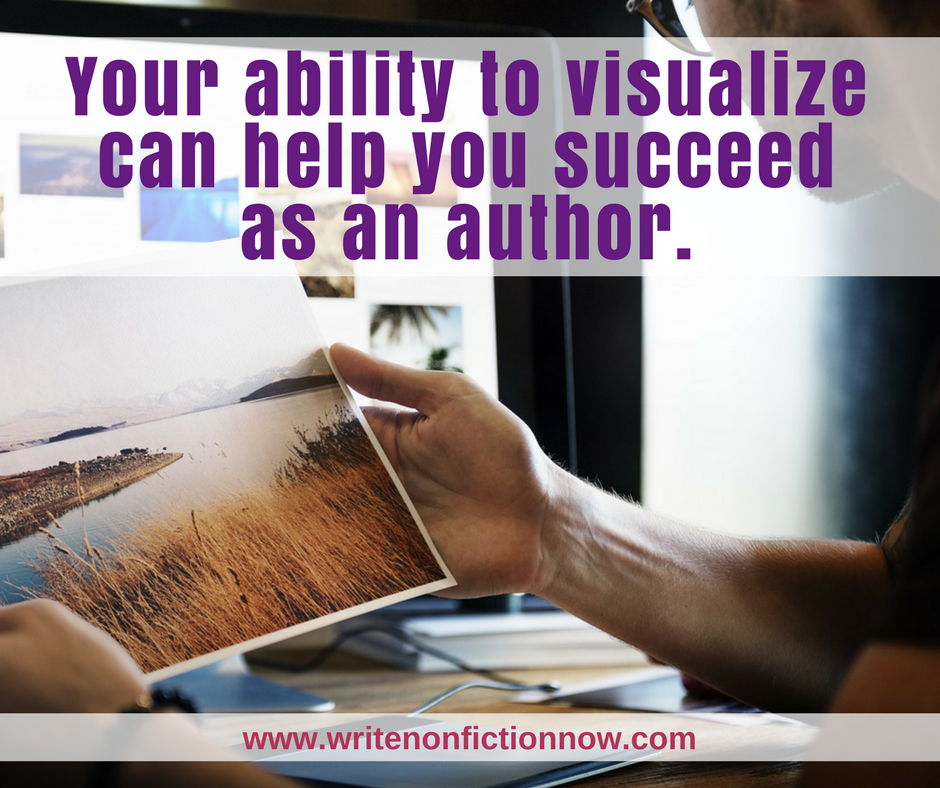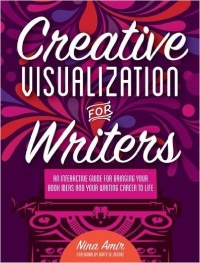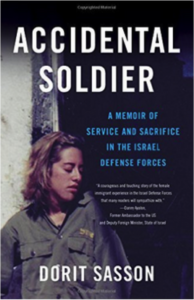Wednesday, February 8, 2017

Although I’ve been using creative visualization for years, and I even published a book about the topic in 2016, many people don’t have any idea of the power imagination has to help them create what they desire. That desire could be for a new car, a relationship, a successfully completed marathon, or a finished book manuscript. It doesn’t matter what you want, creative visualization will help you bring it into your experience. Since this topic is near and dear to my heart, I was thrilled when my colleague Dorit Sasson (), a memoirist and podcaster, asked to write a blog post for me on creative visualization. Here’s her take on the subject.
Creative visualization is one of the most valuable yet overlooked tools in an author’s tool box. This one activity provides the backbone for cultivating success beyond writing and publishing a book.
Think about a time when you got excited by the possibilities of your latest project but somewhere along the way you lost steam.
Or you got stuck while trying to pull research into your writing and felt like throwing the manuscript away forever.
Did you visualize your success at these times? Try it:
Imagine finishing your current work in progress.
See yourself in your mind’s eye as you easily produce page after page of manuscript.
Visualizing what you want can help you get unstuck and move toward your goals.
What is Creative Visualization?
If you’ve never heard of “
creative visualization,” it’s the process of using your thoughts and emotions to consciously imagine, create and attract to yourself what you want to experience or have in your life.
Visualization effectively programs the mind for success and, therefore, helps you achieve your goals and dreams. It’s not difficult to do. Just imagine what you want, feel what it would be like to have it, and believe what you desire is coming to you. Then take action toward your goal.
Allow me to share with you a recent experience. I felt stuck and frustrated. Instead of giving up, I used various creative visualization tools to keep myself anchored and moving forward with my latest writing project.
I had crowdsourced a new book title but hadn’t yet shown in any of the chapter outlines how the concepts of “sand” and “steel,” (which were in the book’s proposed title) were relevant to the larger theme of acculturation. My writing coach picked up on this and suggested I free write around these words. This exercise generated a plethora of ideas.

But still, I felt lost in a sea of words. I also felt I wasn’t making much progress with the manuscript.
So I Googled “images” “sand” and “steel” to see if I had missed anything that could help with my writing.
I was surprised to see pretty pictures of multi-colored sand that looked almost like beads. After looking at them a bit, I realized the importance of acculturating for the cultural diversity of the United States–something I hadn’t experienced for almost 20 years.
I began to “see” new images in my mind related to my book. And I consciously took myself on an imaginary tour of how I wanted sand and steel and acculturation to appear in my work in progress.
The process helped me reconnect with my book project, get inspired, and begin writing again.
This brings me to why and how authors and writers should use creative visualization.
Use Creative Visualization to Jump Start Your Creativity
The solution to getting unstuck is as simple as stirring your curiosity or passion.Click To Tweet
As with any big project, there’s the temptation to simply give up when you feel you aren’t making enough progress to validate your efforts. Sometimes the solution to getting unstuck is as simple as stirring your curiosity or passion about your subject matter.
Hop over to Google whenever you feel stuck, unsure or need additional clarification about your themes, concepts, research–pretty much anything—related to the topic of your book. Look for images and articles related to your passion and topic. Let your curiosity lead you to the next important bit of information.
Use what you find as the starting place for your visualization.
Passion and curiosity are the two most powerful elements you need to get emotionally grounded in the creative visualization process. No matter your endeavor, these two provide the fuel to ignite your imagination and pursue creative visualization.
Use Social Media Images to Inspire Creative Visualization
It makes sense for authors to use an online vision board on Pinterest to stay motivated and focused.Click To Tweet
Because Facebook and Pinterest are visually driven social media platforms, it makes sense for authors to use an online
vision board on Pinterest to stay motivated and focused on their goal of completing a manuscript and publishing a book.
A vision board is a visual depiction of a goal, state of being, or dream. Pinterest provides a fabulous place to create a virtual vision board consisting of images you pin.
Visualizing your writing or publishing goals with the help of Pinterest vision boards can help you take action and commit to your goals. Plus, doing so differentiates you from most people who pursue your craft.
For example, if you’re writing non-fiction, you could pin motivating quotes and sayings around the themes of your book to your Pinterest board as well as images that help you see and feel your goal achieved. Fiction writers can do the same, even pinning images related to their characters. Using
Quozio or
Canva, you can create little posters with meaningful and relevant quotes to stir interest in your latest work as well.
As you pin or create images, use them as opportunities for creative visualization. Place yourself in the images. Use them as opportunities to see and feel your success.
It’s key also to generate feelings as you visualize:
- When you post an image relating to your book on Facebook, how do you feel (about the image)?
- When you share a meme from your book on Twitter, how do you choose to feel about it?
Here’s an added benefit: As you add images related to your goal and people follow you and your board, you build an author platform on Pinterest.
Visualize Yourself Reaching Your Goals
Search out terms like “creativity” and “flow” on Pinterest. Feel into them. Visualize.Click To Tweet
A creative visual is a powerful way to stay committed and focused. For example, if getting a 1,000 Facebook or Twitter fans a month is your goal so you can
show evidence of a platform to publishers and agents, what images support that goal? What visuals depict this achievement? Search them out using Google, and then put them in your Pinterest vision board. Again, use the pictures to visualize and feel your goal achieved.
Hop over to Pinterest and enter a few search terms that describe how you want to feel about your project or goal. See what images appear. You can add them to a Pinterest board. At the same time, generate a feeling to go with that visual cue.
Need to get in the creative flow? Again, search out terms like “creativity” and “flow” on Pinterest. Feel into them. Visualize.
As you post images and visualize your book, help people on social networks do the same. Write a status update or note that encourage them to feel and visualize along with you. Take advantage of the group energy you create. In the process, your platform will grow, as well.
As you can see, there are many ways for writers to use creative visualization to reach a goal and get unstuck.
Have you had any experience using creative visualization? What worked? What didn’t? Share in a comment below!About the Author

 Dorit Sasson
Dorit Sasson is the founder of Giving Voice to Your Courage
podcast and
website. She supports heart-centered business owners and authors build visibility and increase engagement as thought leaders. Her groundbreaking memoir
Accidental Soldier: A Memoir of Service and Sacrifice in the Israel Defense Forces is a finalist for the next Generation Indie Book Awards, USA Best Books awards and the Santa Fe Literary Awards and is also a widely read handbook on how to be more courageous in life.
Photo courtesy of rawpixel / Pixabay.com The post
Why Writers Benefit from Using Creative Visualization appeared first on
Write Nonfiction NOW!.
Nina Amir, the bestselling author of How to Blog a Book and The Author Training Manual, is a speaker, a blogger, and an author, book, blog-to-book, and high-performance coach. Known as the Inspiration to Creation Coach, she helps creative people combine their passion and purpose so they move from idea to inspired action and positively and meaningfully impact the world as writers, bloggers, authorpreneurs, and blogpreneurs. Some of Nina’s clients have sold 300,000+ copies of their books, landed deals with major publishing houses and created thriving businesses around their books. She is the founder of National Nonfiction Writing Month, National Book Blogging Month, and the Nonfiction Writers’ University. As a hybrid author she has published 19 books and had as many as four books on the Amazon Top 100 list at the same time. Her most recent book is called Creative Visualization for Writers, and tomorrow her 19th book will be released, The Write Nonfiction NOW! Guide to Creativity and Flow. Find all her books at booksbyninaamir.com or find out more about her at ninaamir.com.